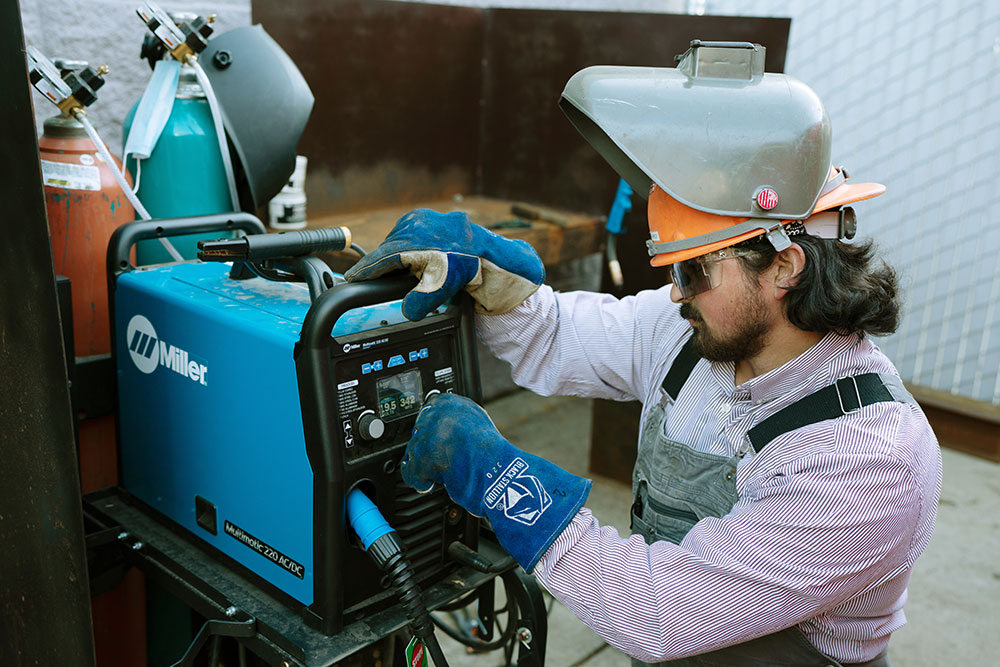Apprentice ironworker gains real-world experience at the University of Iron

In a YouTube video with nearly 6 million views, a slinger pulls a hot iron rivet from the cook with his tongs and then tosses it 20 or so feet to the bucker. The bucker catches the rivet in a metal cone and dumps it off to the riveters, who place it in a hole on a steel I-beam and peen it into place with a pneumatic hammer.
All this “slinging,” “bucking” and “peening” is being carried out by students of the University of Iron in a demonstration of an obsolete—yet instructive—technique that was the standard for the construction of most of the huge projects of the Industrial Revolution, everything from ships to skyscrapers. The Eiffel Tower, for example, is held together with 2.5 million such rivets.
“We were doing a simulation of what it used to be like, and it went viral,” says Michael Rico, an apprentice ironworker enrolled in the program and who was in the class in the video.
The University of Iron is a four-year program that places students in paid internships while they attend approximately 200 hours of classes per year at one of nine campuses across the state. Upon completion, graduates are certified journeymen ironworkers. Coursework completed in the apprenticeship programs counts for credits toward degree programs at community colleges in the state, including American River College and Cosumnes River College in the Sacramento area.
Rico came to the school’s Sacramento training center having already worked in the field as a welder, and was given credit for his previous experience. “They started me off right in the middle. … I was an ironworker already for a non-union company,” he says. “I just have to do a few more of my core classes and I can become a journeyman.”
Those classes are on pause for the moment, however, as Rico and his wife are staying close to home to take care of their firstborn child. But even though he’s yet to graduate, Rico is already reaping the benefits of his pursuit of an ironworker career. As an Ironworkers Union apprentice, his family gets full insurance coverage, which proved crucial during his daughter’s recent birth. “She was free,” Rico says. “We [had to stay] in the hospital at Stanford two nights and three days, and my insurance covered everything.”
Before he joined the University of Iron, Rico learned the skills needed for his previous job in the welding program at Butte College. He was recruited to the current program in 2022 by Raymond Davis, union president of Ironworkers 118. The chapter, founded in 1908, represents more than 1,600 members from Northern California and Nevada.
“The work really is hard, it can be a mind game for sure, but once you start getting traction with what this job is like, it is so worth it. There are so many different aspects of iron work, you can travel the world. It’s friggin’ awesome!”
Michael Rico, University of Iron Apprentice Ironworker
“There’s a pretty cool dynamic in the program. The instructors are all people who’ve been in the field,” Rico says. He adds that the classes also offer a prime networking opportunity: “When you get into class, you try to make friends with everyone.”
The University of Iron is one of the programs under the umbrella of the California Apprenticeship Coordinators Association, offering training in the classroom and on-the-job in dozens of fields—from ironworking to meatcutting. Apprenticeships are also a ticket to the middle class, and Governor Gavin Newsom has set a goal of expanding programs to serve 500,000 apprentices by 2029. The California Community Colleges’ Apprenticeship Pathways initiative—part of the Chancellor’s Office’s Vision 2030 collaborative action plan—is part of that effort. Some of Vision 2030’s objectives are to contribute to the state’s economic growth, as well as ensure that all students—regardless of race, age, economic status or geography—have access to training and education.
Brad Gasaway, apprenticeship coordinator for University of Iron, says it’s a secure field, with plenty of opportunities. “The job outlook is good now in the Sacramento area, and in the future,” he said. “Work is busy and we could always use more hard-working individuals that want to make good money with a retirement and full health benefits.”
When he finishes with University of Iron, Rico says he’d like to do more work alongside big cranes (“I got to do a job with cranes at the Port of Stockton, and it was a lot of fun.”), as well as eventually move into inspection work. “The union helps you get your certified welding inspector’s card,” he says. “That’s a big deal; that’s a hard test to pass. If I can do that, then I can try and be an ironworker who does quality control.”
Wherever he lands, he’s excited and confident in his prospects:
“The opportunities out here, if [someone is] thinking about it. The work really is hard, it can be a mind game for sure, but once you start getting traction with what this job is like, it is so worth it. There are so many different aspects of iron work, you can travel the world. It’s friggin’ awesome!”
For more information on the University of Iron visit universityofiron.org, and for info on other apprenticeship opportunities in the state, go to calapprenticeship.org. Find out more about the CCC’s Apprenticeship Pathways project at the Vision 2030 website: cccco.edu/About-Us/Vision-2030.
Written by Jason Cassidy
| Regions | Classes & Topics |
|---|---|
| Northern California | Apprenticeships |